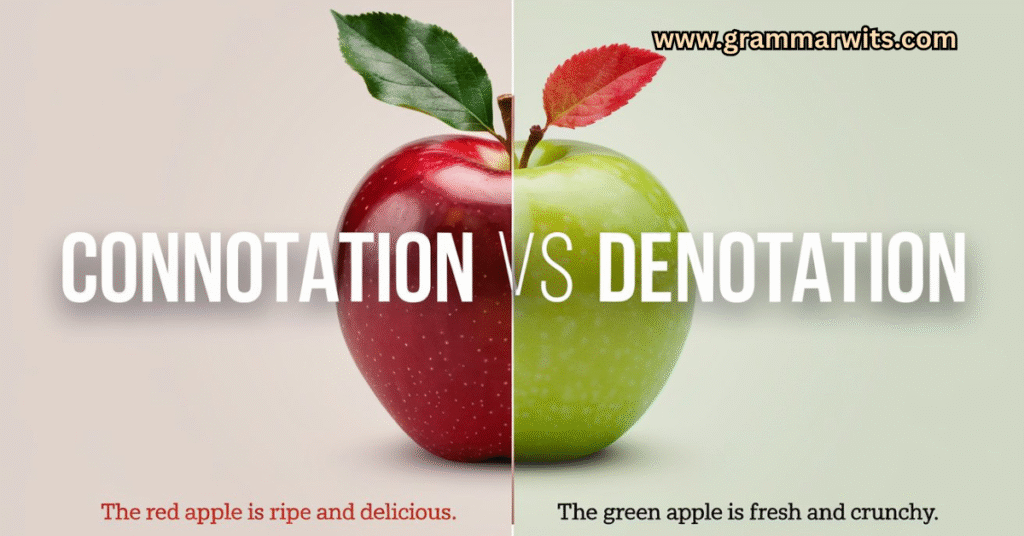Understanding connotation vs denotation is crucial for anyone looking to master communication, whether in writing, speaking, or everyday conversation. Denotation refers to the literal, dictionary definition of a word, while connotation encompasses the emotional and cultural associations it carries beyond its straightforward meaning. These subtle layers often influence how a message is received, making it important to recognize both aspects to communicate with clarity and precision. Understanding the differences in Connotation vs Denotation Definitions is essential for mastering clear and impactful communication.
Language isn’t just about words—it’s about the emotions, memories, and ideas that come attached to them. Think of words as seeds; while the denotation is the seed itself, the connotation is the garden that blooms around it. One wrong word choice can change the entire tone of a sentence, impacting how people react, feel, and respond. Mastering the art of using connotation and denotation effectively can transform simple writing into something truly powerful and memorable.
By exploring connotation vs denotation definitions, you unlock a deeper level of language understanding. It allows you to choose words with greater care, tailoring your message to evoke the precise reaction you intend. Whether crafting a persuasive argument, writing poetry, or navigating sensitive conversations, recognizing these subtle differences gives you an undeniable edge. Let’s dive deeper into how these two powerful elements of language shape our communication every day.
The Core Distinction: Beyond Dictionary Definitions
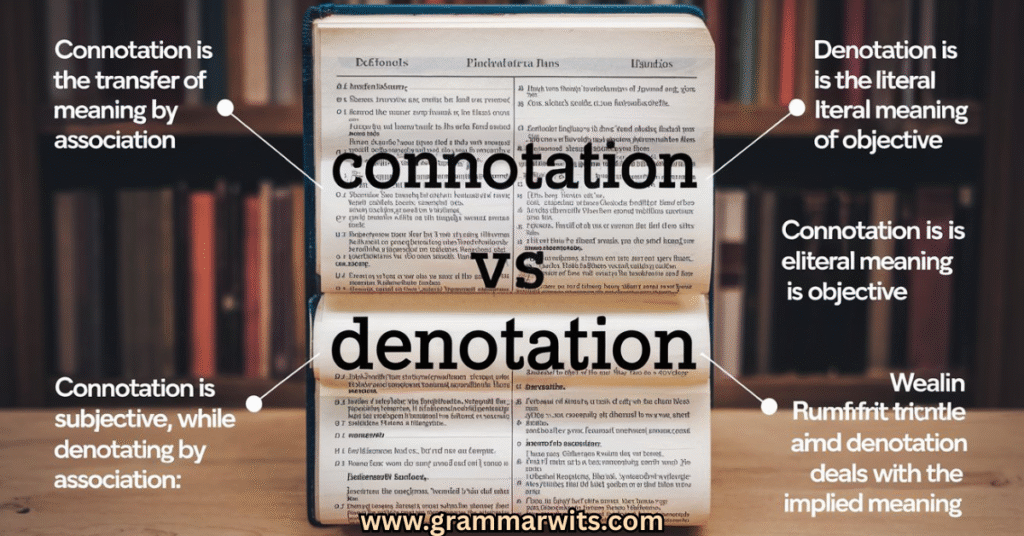
When we communicate, two parallel processes of understanding occur simultaneously: we grasp what words technically mean (denotation) while processing their emotional and cultural baggage (connotation).
Connotation vs denotation definitions revolve around this fundamental difference: denotation is about the explicit, literal meaning, while connotation encompasses the feelings, associations, and implications that words carry beyond their dictionary definitions.
“In the difference between the bare meaning of words and the feelings they create lies the magic of all art.” — Professor James Engell, Harvard University
This distinction matters immensely because misunderstandings often arise not from failing to understand what words mean, but from missing what they imply within specific contexts or cultures.
Common misconceptions about connotation vs denotation definitions include thinking that:
- Only literary language has connotations
- Formal communication relies solely on denotation
- Connotations are always intentional
- Dictionary definitions never change
None of these assumptions are accurate, as we’ll explore throughout this article.
Denotation: The Literal Foundation
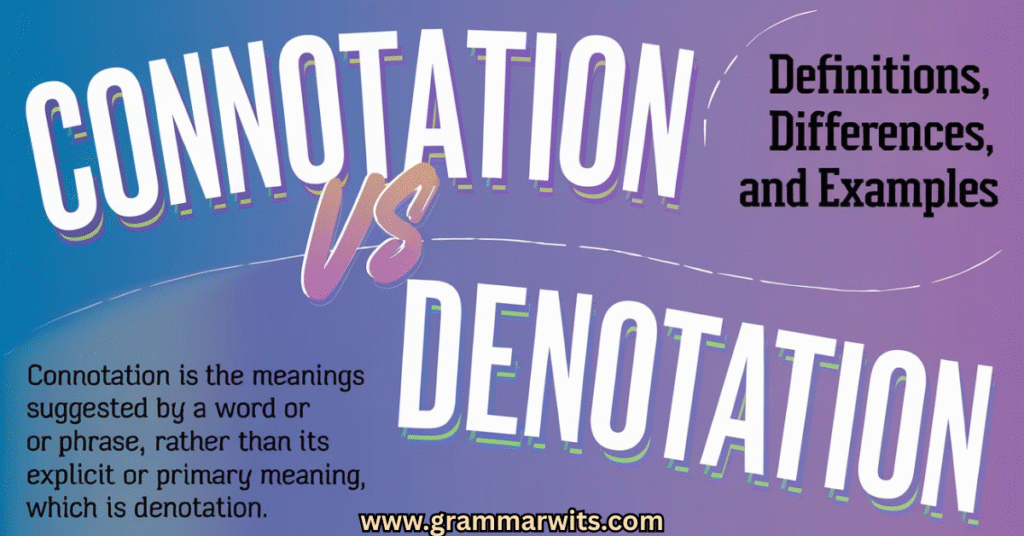
It refers to the direct, explicit, and literal meaning of a word—the definition you’d find in a dictionary. The term derives from the Latin “denotare,” meaning “to mark out plainly.”
Characteristics of Denotative Meaning
- Objective and factual
- Generally agreed upon by speakers of a language
- Independent of context
- Relatively stable over time
- Serves as the foundation for more complex meanings
For example, the denotation of “home” is simply “a place where one lives permanently.” This dictionary definition provides a neutral, factual foundation that all speakers of English can agree upon regardless of their personal experiences with homes.
Denotative language serves as the bedrock of clear communication. It provides stability and prevents language from becoming entirely subjective. Without agreed-upon denotations, effective communication would be impossible.
How Dictionaries Capture Denotative Meaning
Dictionaries attempt to document the lexical meaning of words as objectively as possible. However, even dictionaries must occasionally update definitions as language evolves.
| Word | Historical Denotation | Modern Denotation |
|---|---|---|
| Nice | Precise, careful | Pleasant, agreeable |
| Awful | Inspiring awe | Very bad or unpleasant |
| Cloud | Visible mass of water droplets | Also, online storage system |
| Tweet | Bird sound | Also, short online message |
This table demonstrates that even denotations aren’t completely fixed—they evolve as societies and technologies change, albeit more slowly than connotations.
Connotation: The Emotional Layer

It encompasses the emotional, cultural, and associative meanings attached to a word beyond its literal definition. The term comes from the Latin “connotare,” meaning “to mark along with.”
Connotations are:
- Subjective and emotional
- Culturally dependent
- Contextually variable
- More fluid and changeable than denotations
- Often unconsciously processed
For instance, while “home” denotatively means “a place where one lives,” its connotations might include safety, family, comfort, belonging, or in negative contexts, conflict or restriction.
Types of Connotations
Connotations generally fall into three categories:
- Positive connotation: Words that evoke favorable feelings or associations
- Example: slim, economical, confident
- Negative connotation: Words with unfavorable associations
- Example: skinny, cheap, arrogant
- Neutral connotation: Words with minimal emotional associations
- Example: thin, inexpensive, assured
Connotation vs denotation definitions highlight how the same basic concept can be expressed with drastically different emotional implications while maintaining similar denotative meaning.
Cultural Variations in Connotations
What makes connotation particularly complex is how it varies across cultures, generations, and communities. For example:
- The color white connotes purity and weddings in Western cultures but can symbolize death and funerals in some Eastern traditions
- “Ambitious” carries positive connotations in American culture but may have negative implications in some traditional societies
- Food terms like “fat” have shifted from positive connotations (implying wealth) to negative ones in modern society
Understanding these variations is critical for effective cross-cultural communication and explains why direct translations often fail to capture the full meaning of texts.
Critical Differences: A Side-by-Side Analysis
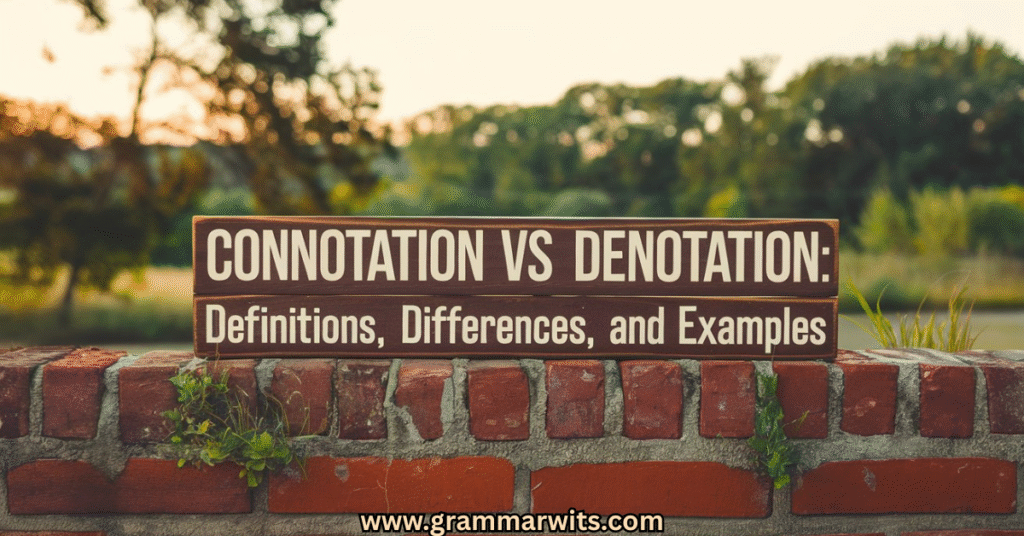
To fully grasp connotation vs denotation definitions, consider these fundamental distinctions:
Dictionary vs. Cultural Understanding
Denotation relies on formal, codified knowledge found in dictionaries and represents what linguists call objective meaning. In contrast, connotation draws on cultural knowledge and represents subjective meaning that varies across communities and contexts.
Objective vs. Subjective Interpretation
Denotative meaning can generally be verified as factually correct or incorrect. For example, calling a four-legged canine pet a “cat” would be denotatively wrong. However, connotative meaning exists in the realm of perception and association—it’s not about correctness but about the feelings and images a word evokes.
Universal vs. Contextual Application
Fixed meaning is a characteristic of denotation—a table means a piece of furniture with a flat top and legs regardless of who’s speaking. But flexible meaning through connotation depends entirely on context—”table” in a discussion about data refers to something completely different.
Static vs. Evolving Nature
While both aspects of language evolve, denotations typically change slowly through formal processes, while connotations can transform rapidly through cultural shifts, media influence, political events, or even viral moments online.
This table summarizes these differences:
| Aspect | Denotation | Connotation |
|---|---|---|
| Source | Dictionaries | Cultural knowledge |
| Nature | Objective | Subjective |
| Stability | Relatively fixed | Highly variable |
| Verification | Can be verified as correct/incorrect | Based on perception |
| Universality | Generally universal within a language | Varies by context and culture |
| Evolution | Changes slowly | Can change rapidly |
Connotation & Denotation in Action: Powerful Examples
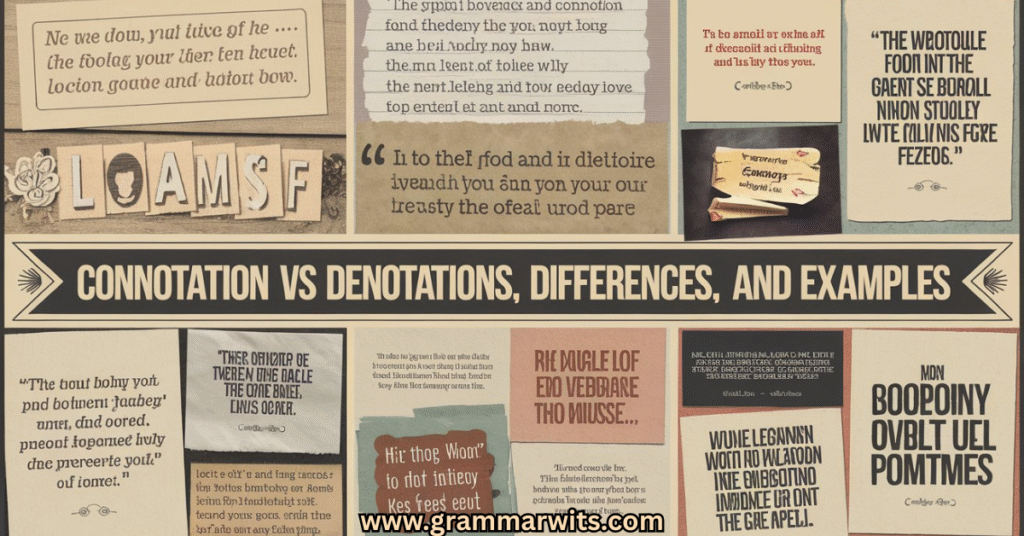
The interplay between connotation vs denotation is evident across various domains of communication. Let’s examine how these linguistic phenomena operate in different contexts.
Literature Examples
In literature, authors deliberately manipulate the tension between denotative and connotative meaning to create rich, layered text:
Case Study: Robert Frost’s “The Road Not Taken”
- Denotation: Literally describes two physical paths in a forest
- Connotation: Symbolizes life choices, individuality, regret, and the human tendency to rationalize decisions
“Two roads diverged in a wood, and I— I took the one less traveled by, And that has made all the difference.”
The literal definition of “road” here serves as a vehicle for much deeper implied meaning. The connotative language transforms a simple woodland scene into one of the most quoted poems about life choices.
Advertising Case Studies
Advertisers are masters of connotation, carefully selecting words for their emotional impact rather than their literal meaning:
Bold Example: Car Marketing
- Economy car described as “efficient” (positive connotation) rather than “cheap” (negative connotation)
- Sports car described as “powerful” rather than “gas-guzzling”
- Family vehicle described as “spacious” rather than “large”
Each of these word choices maintains similar denotative meaning while dramatically altering the emotional impact on potential buyers.
Political Speech Analysis
Political language represents perhaps the most sophisticated manipulation of connotation vs denotation:
Example: Tax Policy Language
- “Tax relief” vs. “Tax cuts” vs. “Tax breaks”
- Denotatively similar: all refer to reduced taxation
- Connotatively different: “relief” implies taxes are a burden; “cuts” suggests decisive action; “breaks” might imply special treatment
These subtle distinctions in political rhetoric can dramatically influence public opinion without changing the substance of the policies being described.
Everyday Conversation Examples
Even in daily interactions, the distinction between connotation vs denotation definitions affects relationships:
- “You’re persistent” vs. “You’re stubborn”
- “You’re careful with money” vs. “You’re cheap”
- “You’re confident” vs. “You’re arrogant”
In each pair, the denotative meaning remains similar while the connotative meaning shifts dramatically from compliment to criticism.
Journalism Examples
News media demonstrates how word choice influences audience understanding:
- “Freedom fighters” vs. “rebels” vs. “terrorists”
- “Undocumented immigrants” vs. “immigrants”
- “Climate change” vs. “global warming”
Each term may refer to the same people or phenomena (denotation) but carries vastly different emotional associations and frames the subject in distinctive ways that influence how readers perceive the information.
The Evolution of Word Meanings
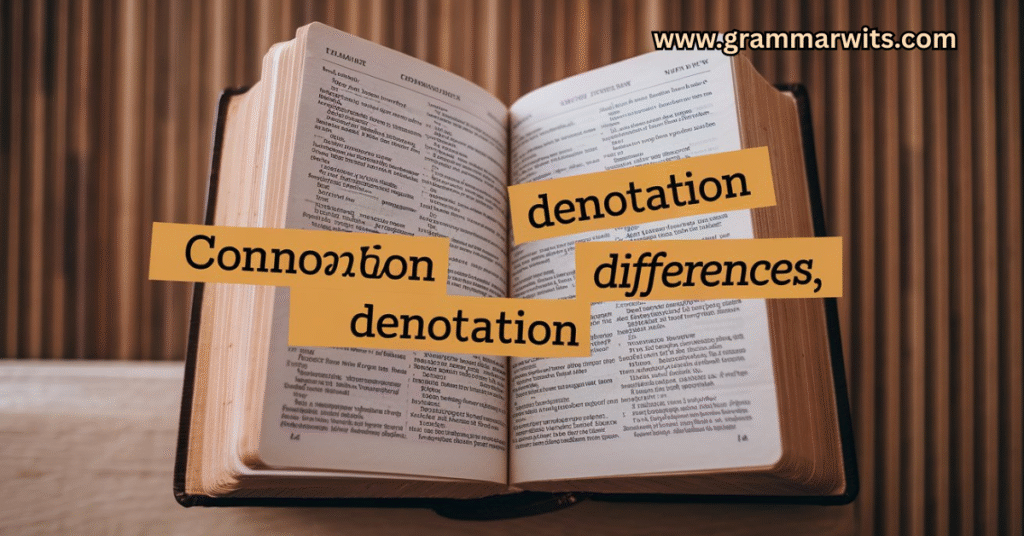
Both denotation and connotation evolve over time, though typically at different rates and through different mechanisms.
Historical Shifts in Meaning
Some words have undergone dramatic transformations in both their literal definition and emotional meaning:
| Word | Original Denotation | Original Connotation | Modern Denotation | Modern Connotation |
|---|---|---|---|---|
| Gay | Happy, carefree | Positive | Homosexual | Neutral/Positive (but context-dependent) |
| Artificial | Made with skill | Positive (showcasing human ingenuity) | Not natural | Often negative (fake, inferior) |
| Nervous | Sinewy, vigorous | Positive | Anxious, worried | Negative |
Case Studies of Dramatic Word Evolution
Awesome:
- Historical denotation: Inspiring fear or dread
- Historical connotation: Overwhelming, terrifying
- Modern denotation: Excellent
- Modern connotation: Highly positive, impressive
Connotation vs denotation definitions help explain how “That’s awesome!” shifted from expressing terror to expressing enthusiasm without any formal redefinition of the word.
How Language Evolution Affects Communication
Understanding how words evolve helps us:
- Interpret historical texts accurately
- Recognize generational communication gaps
- Anticipate future linguistic shifts
- Adapt to changing language norms
This evolution demonstrates that lexical meaning is not static but exists in constant dialogue with cultural developments and sociocultural word meanings.
Strategic Application: Using These Concepts Effectively
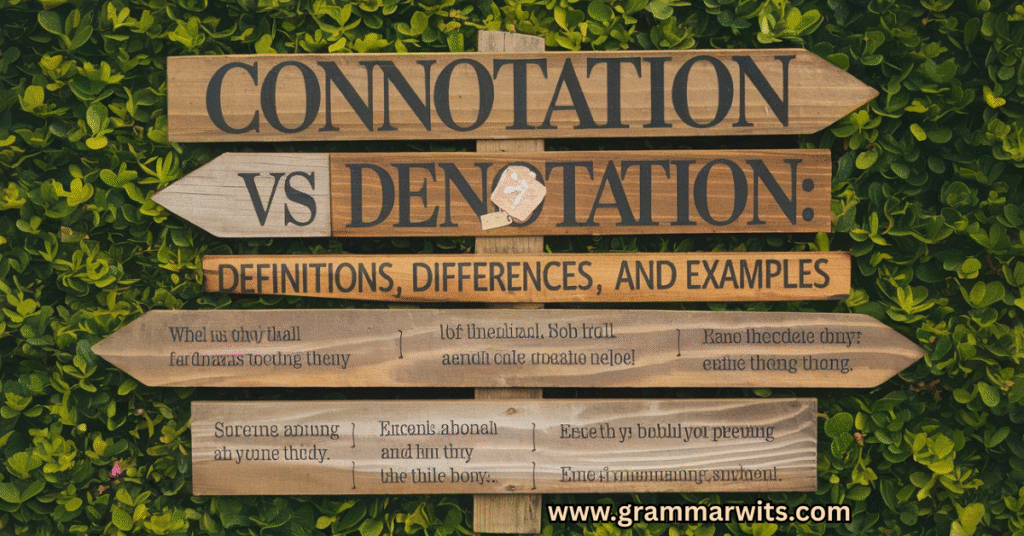
Knowledge of connotation vs denotation provides practical advantages in communication, especially in writing and persuasion.
Writing Tips for Controlling Connotations
- Keep your audience in mind: Age, cultural background, and political views all affect how connotations are perceived
- Create word banks: Collect alternatives with similar denotations but different connotations
- Test interpretations: When writing important communications, have others review for unintended connotations
- Study euphemisms and dysphemisms: Understanding these specialized forms of connotative language helps you recognize and use them appropriately
Communication Strategies for Clarity
When precision matters:
- Define terms explicitly
- Use technical language with precise denotations
- Acknowledge potential connotations directly
- Choose words with neutral emotional associations when presenting factual information
When persuasion matters:
- Select words with connotations that align with your audience’s values
- Use positive connotation examples for concepts you want to promote
- Apply negative connotation examples to concepts you want readers to reject
- Create new associations through consistent pairing of concepts
How to Detect Manipulative Language Use
Becoming aware of connotation vs denotation definitions helps protect against language manipulation:
- Question why specific terms were chosen over their synonyms
- Identify emotionally charged words and consider their neutral alternatives
- Recognize euphemisms that obscure harsh realities
- Notice how the same events are described differently by different sources
Tools for Analyzing Connotative Patterns
Several resources can help analyze connotative language:
- Sentiment analysis software
- Linguistic corpora showing how words appear in context
- Historical dictionaries tracking meaning evolution
- Cross-cultural communication guides
These tools help writers and speakers navigate the complex landscape of word perception and emotional impact.
Digital Age Implications
The digital revolution has dramatically accelerated and complicated the dynamics of connotation vs denotation.
Social Media and Connotation Amplification
Social platforms have created new mechanisms for rapidly shifting connotations:
- Terms can gain new associations through viral events
- “Hashtag hijacking” can deliberately alter word associations
- Online communities develop specialized vocabularies with unique connotations
- Terms can become “coded language” with meanings only apparent to insiders
The speed of these changes challenges traditional understanding of how language evolves.
AI Language Processing Challenges
Artificial intelligence systems struggle with connotation in ways that highlight the complexity of human language:
- Machine translation often preserves denotation but loses connotation
- Content moderation systems may miss offensive content that relies on connotative rather than denotative meaning
- AI writing assistants may suggest inappropriate synonyms by focusing on denotation alone
- Natural language processing must be constantly updated to track shifting connotations
These challenges reveal how deeply connotative meaning is tied to human experience and cultural knowledge.
Global Communication and Cultural Connotation Barriers
As communication becomes increasingly global, navigating different cultural associations grows more challenging:
Example: Business Communication When a North American company described their software as “aggressive” (positive connotation of assertiveness), their Japanese partners understood it as indicating hostility (negative connotation).
Connotation vs denotation definitions become particularly important in globalized contexts where direct translation often fails to capture cultural nuances.
Expert Insights: Linguistic Perspectives
Scholars of semantics have developed sophisticated frameworks for understanding the relationship between connotation vs denotation.
Quotes from Semantic Scholars
“Denotation is the skeleton of meaning; connotation is its living flesh.” — Professor Angela Goddard, Critical Discourse Analysis
“Words are never innocent. They have histories, associations, and agendas that operate beneath their surface meanings.” — Dr. James Martin, Discourse Semantics Expert
“The connotation of a word is like its shadow—sometimes larger than the word itself, sometimes almost invisible, but always attached to it.” — Dr. Sarah Ahmed, Cultural Linguistics
These expert perspectives emphasize that connotation vs denotation definitions cannot be fully separated—they exist in constant relationship.
Research Findings on Connotation Processing
Recent neurolinguistic research has revealed:
- Emotional associations are processed more quickly than literal meanings
- Different brain regions activate when processing denotative vs. connotative aspects of words
- Connotative processing is more closely linked to memory and personal experience
- Cultural background influences which brain networks activate during language processing
These findings suggest that connotation isn’t merely an add-on to meaning but an integral part of how we process language neurologically.
How Our Brains Process Different Aspects of Meaning
The brain processes denotative and connotative meaning through different but interconnected neural pathways:
- Denotative processing primarily engages areas associated with factual knowledge and categorization
- Connotative processing activates emotional centers and autobiographical memory
- Context determines which pathway dominates in a given situation
- Fluent language users switch between these modes unconsciously
This neurological reality explains why connotation vs denotation definitions can’t be completely separated in practice—our brains process both simultaneously.
Conclusion
The distinction between connotation vs denotation lies at the heart of how language functions. Denotation provides the stable foundation of agreed-upon meanings that make communication possible, while connotation adds the rich layers of emotional, cultural, and personal association that make language powerful.
Understanding these concepts isn’t merely academic—it’s practical knowledge that helps us:
- Communicate more precisely
- Interpret messages more accurately
- Detect manipulation attempts
- Write more persuasively
- Navigate cross-cultural interactions
- Appreciate linguistic art forms
As we’ve seen throughout this exploration, connotation vs denotation definitions focus on the difference between what words literally mean and what they suggest or imply. This distinction shapes every aspect of human communication, from intimate conversations to international diplomacy.
By becoming more conscious of these dual aspects of meaning, we gain greater control over our own language use and greater resistance to manipulation through language. In a world increasingly dominated by persuasive communication, this awareness becomes not just useful but essential.
FAQs About Connotation and Denotation
Can a word’s connotation change its denotation over time?
Yes. When connotations become widespread enough, they often eventually affect denotative meaning. For example, “literally” now includes an additional definition acknowledging its use for emphasis rather than factual accuracy. This process, called semantic drift, shows how flexible meaning can eventually influence fixed meaning.
How do writers strategically use connotation?
Writers use connotation to:
- Establish mood and atmosphere
- Develop characterization through speech patterns
- Create subtext and layered meanings
- Influence readers’ emotional responses
- Connect new concepts to familiar feelings
- Control tone and emotional impact
Mastery of connotative language distinguishes skilled writers from merely competent ones.
Are connotations universal across cultures?
No. Connotations vary dramatically across cultures. Color associations, animal symbolism, and even basic concepts like time and space carry different emotional associations in different cultural contexts. This variation makes cross-cultural communication challenging but also enriches global literature and art.
How do dictionaries handle connotations?
Modern dictionaries typically:
- Focus primarily on denotative meaning
- Note strong connotations with labels like “pejorative,” “offensive,” or “euphemistic”
- Include usage notes for words with particularly significant cultural or emotional associations
- Update more frequently to track changing connotations
However, dictionaries can never fully capture all connotative meaning since it varies by context and audience.
Can words have multiple denotations but similar connotations?
Yes. For example:
- “Large,” “enormous,” “gigantic,” and “massive” have different technical meanings (denotations) but share positive or negative connotations depending on context
- Technical terms across different fields may have field-specific denotations but share connotations of expertise and precision
This phenomenon helps explain why certain words cluster together in usage despite subtle denotative differences.
How do translators handle connotations across languages?
Translators use several strategies:
- Prioritizing either denotation or connotation based on text purpose
- Adding explanatory notes for culturally specific connotations
- Finding target language terms with similar emotional impact rather than literal meaning
- Preserving metaphors when possible or creating new ones with equivalent effect
- Considering the target audience’s cultural knowledge
The challenge of preserving both denotative and connotative meaning makes translation an art as much as a science and explains why literary translation is particularly demanding.

Alizy Smith is a passionate language enthusiast and the admin of Grammar Wits. With a love for wordplay, grammar quirks, and witty expressions, she’s dedicated to making language learning fun and accessible. From grammar tips to pun-filled laughs, Alizy ensures every piece of content entertains while educating — turning tricky rules into easy, enjoyable reads.
